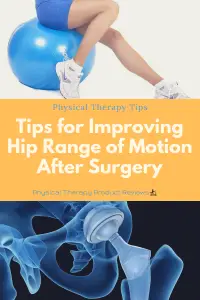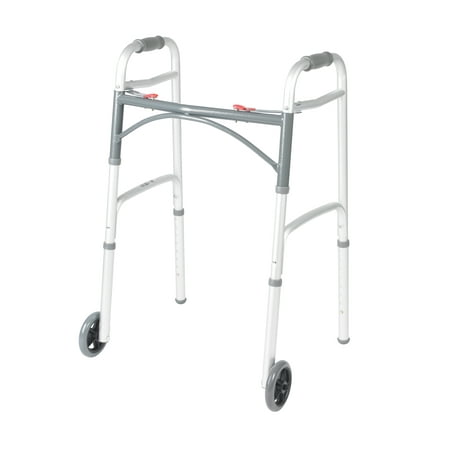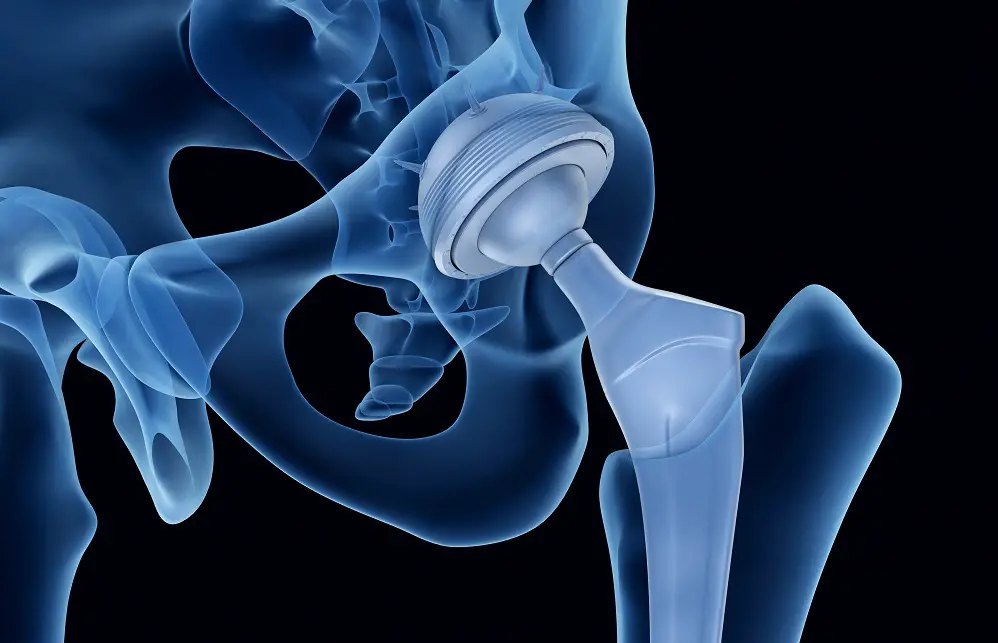Improving Hip Range of Motion After a Hip Replacement
 Total hip replacement surgery is a very common procedure with over 300,000 performed annually (1). Most people who require surgery are between 50 to 80 years of age. During hip replacement surgery, damaged bone and cartilage are removed and replaced with prosthetic components made of metal, ceramic, or plastic (1).
Total hip replacement surgery is a very common procedure with over 300,000 performed annually (1). Most people who require surgery are between 50 to 80 years of age. During hip replacement surgery, damaged bone and cartilage are removed and replaced with prosthetic components made of metal, ceramic, or plastic (1).
One of the challenges that occur after the procedure is the stiffness of the hip joint. This can prove to be a roadblock, or at least a speedbump, while on the path to recovery. In this article, we hope to equip you with the knowledge and techniques to help you manage and overcome hip stiffness so that you can quickly gain a good range of motion (ROM) and stay on track with your post-surgery rehabilitation.
Why Your Hip is Stiff After Surgery?
There are a few different factors that can contribute to the stiffness of the hip joint after replacement surgery.
 First, swelling and pain are very common after any surgery and can lead to decreased flexibility.
First, swelling and pain are very common after any surgery and can lead to decreased flexibility.- Additionally, after tendons and ligaments are cut they can lose some of their elasticity and therefore their movements can be very rigid.
- Since the muscles around the joint aren’t being stretched and used after surgery they can get very stiff.
- Lastly, when recovering from a surgery the joint isn’t being used as frequent. The lack of use means it is not pumping blood and other fluid in and out of the joint to help with stiffness
How Long Will My Hip Be Stiff After My Hip Replacement?
The time it takes to regain mobility can be as short as six weeks but can likely be as long as four to six months. The time frame really depends on a few different factors:
- how active an individual is before and after surgery
- how healthy they are overall
- the rate at which their body can heal
After surgery, it is common for hips to feel stiff in the morning but does feel better once it gets moving. This is common and should go away anywhere from 6-9 months after surgery.
Tips To Improve Hip Mobility After Hip Surgery
In order to improve your time frame to regaining hip flexibility please consider practicing the following tips:
Use Walker or Cane Until you Can Walk Without a Limp
 One important thing to remember is to use a cane or walker until you are no longer limping. If you ditch the cane too early you could inadvertently cause stress to the hip joint. Also, scar tissue could quickly form which can dramatically decrease the likelihood of the surgery’s success. However, if you stick with the walker long enough then you’ll be rewarded with fewer complications down the road. Also, don’t forget that you can often get a cheaper walker online than you would get from the hospital or from the surgeon’s office. See our review of the best walkers for after surgery to get the best deal for the same walkers.
One important thing to remember is to use a cane or walker until you are no longer limping. If you ditch the cane too early you could inadvertently cause stress to the hip joint. Also, scar tissue could quickly form which can dramatically decrease the likelihood of the surgery’s success. However, if you stick with the walker long enough then you’ll be rewarded with fewer complications down the road. Also, don’t forget that you can often get a cheaper walker online than you would get from the hospital or from the surgeon’s office. See our review of the best walkers for after surgery to get the best deal for the same walkers.
Exercise Your New Hip
During post-surgery recovery, movement is your best friend. Remember the phrase, “motion is lotion.” Maintaining continual movement is critical for several reasons. First, movement can actually improve pain. Normally we may assume that we need to rest after surgery to help prevent or relieve pain; however, recently repaired joints actually hurt less with motion. Also, movement can help to circulate blood and prevent blood clots. Another benefit of improved circulation is reduced swelling and improved muscle relaxation and recovery. One of the best ways to get movement in the hip is with a recumbent elliptical. This is a machine that you can sit down and move your legs in a bike like motion without aggravating the hip. 
Walk Often and Walk Backwards
Another powerful tip for improving mobility is to walk multiple times a day as this will help to loosen things up. Try to walk for 10-15 minutes at a time and shoot for 3-5x a day. This is long enough to pump the swelling out after surgery without overdoing it. Also, try walking backward. This is best done in the house in a safe place such as a hallway. By walking backward, you activate the glute muscles and stretches out the hip flexors all the same time. This is also a great way to train the brain to reduce any limping that you have after surgery. Finally, the glute muscles greatly help to provide support to the hip joint.
Emphasize Glute Strength
Building on the previous tip, it is highly recommended that you strive to perform exercises that target the glutes, the hip abductors, and the extensors. Strengthening these muscle groups will help to stabilize the joint and assist in achieving its full extension and range of motion. Depending on the approach used by the surgeon, whether going through the glutes or using the anterior approach, the glutes are the most important area to target post-surgery. Some of our favorite exercises to strengthen the glutes only need a small resistance band and can be found on youtube here.
Stretch Your Hip Flexors
The hip flexors are essentially the muscles that help you to bend at the waist and are one of the primary muscle groups used when bringing your knees to your chest (2). It is especially important for people recovering from hip surgery to stretch them in order to prevent a number of complications, such as hip flexor tendonitis, low back pain, long term tightness, and weakness in other nearby muscles. The hip flexor often goes into “protect” mode after surgery and feel tight for weeks after surgery. Here are 3 great ways to stretch your hip flexors after surgery.
Manage Swelling
We’ve already noticed how maintaining continual movement can improve swelling and it is truly a tip that cannot be emphasized enough. You can also keep swelling at bay by applying ice and pressure (compression bandage) to the hip when you are resting it. Lastly, try to find a good balance when it comes to resting and activity. You want to avoid sitting for too long but you also need to resist doing too much activity. Either extreme can lead to increased swelling, so finding a happy medium is key.
Conclusion
Recovering from hip replacement surgery can be a challenge for a number of reasons. One of the primary issues that have to be addressed is joint stiffness. However, if you follow the strategies highlighted above you will be better prepared to overcome this problem and can potentially shorten the time of your recovery so that you can be back to doing the things you love.
Works Referenced:
- Foran, Jared, et al. “Total Hip Replacement.” OrthoInfo. Last reviewed August. https://orthoinfo.aaos.org/en/treatment/total-hip-replacement/
- Nall, Rachel. “Hip Flexor Strain.” Healthline. Last reviewed July 2017. https://www.healthline.com/health/hip-flexor-strain
Disclaimer: The information provided in this post is for educational purposes only. This is not a substitute for a medical appointment. Please refer to your physician before starting any exercise program.


